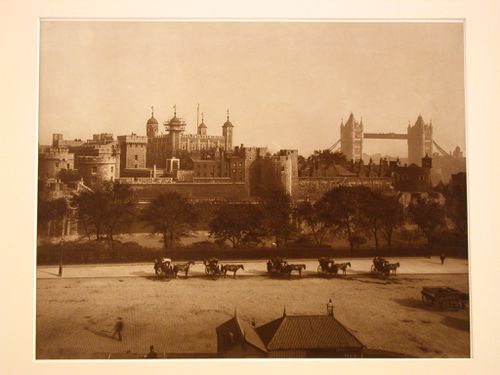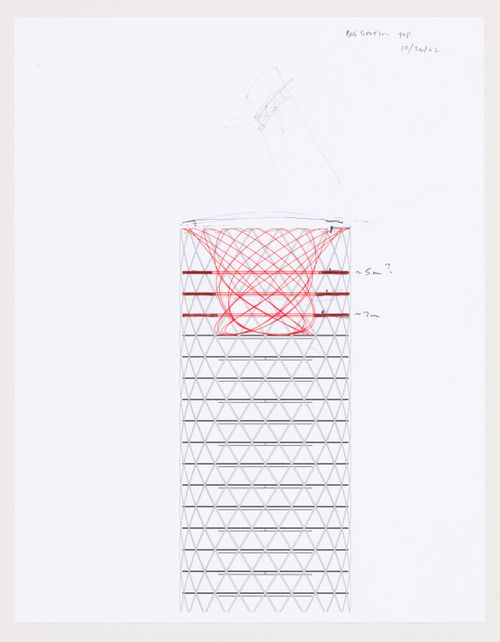drawings
Quantity:
3 drawing(s)
Citicorp Tower
DR1994:0206:001-003
architecture
1965-1991
drawings
Quantity:
3 drawing(s)
1965-1991
architecture
Project
Tower, Canary Wharf
AP142.S1.D156
Description:
File documents an unexecuted project for an office tower in the Canary Wharf development for Olympia & York in London, England. Material in this file was produced in 1990. File contains presentation drawings.
1990
Tower, Canary Wharf
Actions:
AP142.S1.D156
Description:
File documents an unexecuted project for an office tower in the Canary Wharf development for Olympia & York in London, England. Material in this file was produced in 1990. File contains presentation drawings.
File 156
1990
Project
Beekman Place Tower
AP022.S1.1984.PR15
Description:
File documents two schemes for a residential tower (not built), located at Beekman Place between 50th and 51st streets, New York, New York. File contains design development drawings, photographic material, and textual records (includes photographs).
1984-1985
Beekman Place Tower
Actions:
AP022.S1.1984.PR15
Description:
File documents two schemes for a residential tower (not built), located at Beekman Place between 50th and 51st streets, New York, New York. File contains design development drawings, photographic material, and textual records (includes photographs).
Project
1984-1985
photographs
P.O. Tower & Cranes
DR2004:1342
Description:
views of the British Telecom Tower (also known as the Post Office Tower) and nearby construction cranes
1985
P.O. Tower & Cranes
Actions:
DR2004:1342
Description:
views of the British Telecom Tower (also known as the Post Office Tower) and nearby construction cranes
photographs
1985
PH1981:0448
printed between 1876 and 1889
Project
Carbon Tower (2001)
AP174.S1.2001.D1
Description:
This project file documents an unbuilt design by Testa & Weiser for Carbon Tower (2001), a forty-storey building made almost entirely of carbon fibre. The project was developed in parallel with scripting software designed while Peter Testa and Devyn Weiser co-directed the Emergent Design Group at MIT. "The tower consists of an interdependent set of parts: floor plates hang from a diagrid structure of bundled fibres reinforced by two double-helix covered ramps, which are run in and out of the structure and are themselves made of strands woven at a finer scale. A thin composite skin—glass would be too heavy—wraps the tower’s parts together. A collaboration with Arup in 2002 allowed Testa & Weiser to simplify the scheme even further, by moving all core elements, from elevators to structural supports, to the tower’s perimeter. To take full advantage of the flexibility and energy efficiency of composite materials, Testa & Weiser also imagined that the carbon fibre structures would be formed on site through a process called pultrusion."[1] The file contains a large number of digital files documenting the conceptual and design development of the project; consultation with Arup Consulting Engineers, New York; research on composite materials; fabrication of 3D printed physical models by 3D Systems and Windform; and exhibition of the project at several museums and galleries, including the Museum of Contemporary Art, Los Angeles and the Cooper-Hewitt Smithsonian Design Museum, New York. Also contained in the file are 56 paper drawings (including some sketches done on top of printed computer-aided designs) and two 3D printed physical models produced by 3D Systems. Sources: [1] Canadian Centre for Architecture. Archaeology of the Digital 12: Testa & Weiser, Carbon Tower, ed. Greg Lynn (2015), ISBN 978-1-927071-25-0.
2002-2014
Carbon Tower (2001)
Actions:
AP174.S1.2001.D1
Description:
This project file documents an unbuilt design by Testa & Weiser for Carbon Tower (2001), a forty-storey building made almost entirely of carbon fibre. The project was developed in parallel with scripting software designed while Peter Testa and Devyn Weiser co-directed the Emergent Design Group at MIT. "The tower consists of an interdependent set of parts: floor plates hang from a diagrid structure of bundled fibres reinforced by two double-helix covered ramps, which are run in and out of the structure and are themselves made of strands woven at a finer scale. A thin composite skin—glass would be too heavy—wraps the tower’s parts together. A collaboration with Arup in 2002 allowed Testa & Weiser to simplify the scheme even further, by moving all core elements, from elevators to structural supports, to the tower’s perimeter. To take full advantage of the flexibility and energy efficiency of composite materials, Testa & Weiser also imagined that the carbon fibre structures would be formed on site through a process called pultrusion."[1] The file contains a large number of digital files documenting the conceptual and design development of the project; consultation with Arup Consulting Engineers, New York; research on composite materials; fabrication of 3D printed physical models by 3D Systems and Windform; and exhibition of the project at several museums and galleries, including the Museum of Contemporary Art, Los Angeles and the Cooper-Hewitt Smithsonian Design Museum, New York. Also contained in the file are 56 paper drawings (including some sketches done on top of printed computer-aided designs) and two 3D printed physical models produced by 3D Systems. Sources: [1] Canadian Centre for Architecture. Archaeology of the Digital 12: Testa & Weiser, Carbon Tower, ed. Greg Lynn (2015), ISBN 978-1-927071-25-0.
Project
2002-2014
textual records
ARCH267030
Description:
This group consists of correspondence with the Tower Company Ltd., and related documents concerning the Kindergarten of the City of Vienna at Expo 67, in Montreal, Québec.
1967
Kindergarten / Correspondence Tower
Actions:
ARCH267030
Description:
This group consists of correspondence with the Tower Company Ltd., and related documents concerning the Kindergarten of the City of Vienna at Expo 67, in Montreal, Québec.
textual records
1967
drawings
Perspective details of tower
ARCH284248
Description:
Details of tower
1983
drawings
1983
ARCH276857
26 October 2002
models
Strand Tower model
ARCH286151
Description:
3D printed 1:125 scale metric model produced by 3D Systems in Germany of the final iteration of Strand Tower, sometimes referred to in the records as "MMOG" or "Mary Mother of God". The model was created using selective laser sintering (SLS) and is in several pieces.
2006
Strand Tower model
Actions:
ARCH286151
Description:
3D printed 1:125 scale metric model produced by 3D Systems in Germany of the final iteration of Strand Tower, sometimes referred to in the records as "MMOG" or "Mary Mother of God". The model was created using selective laser sintering (SLS) and is in several pieces.
models
2006

